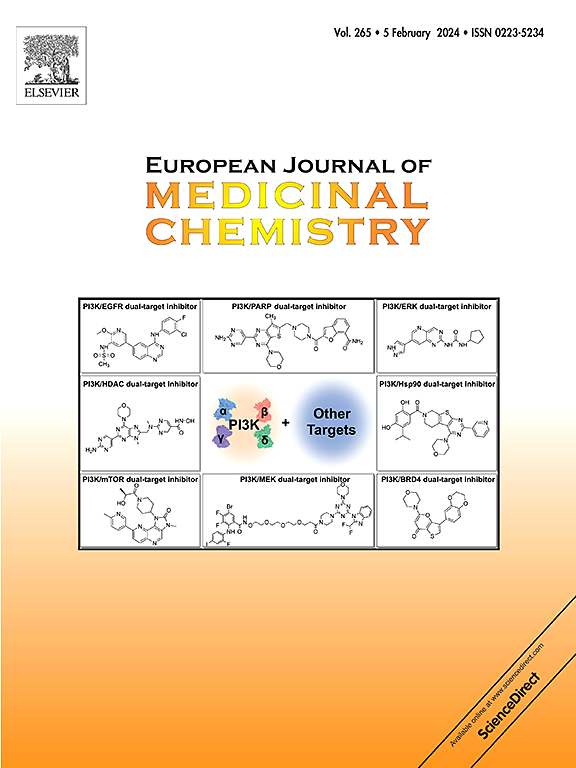Structure-guided expansion strategy unveils potent allosteric SHP2 inhibitors with synergistic efficacy against AML through MCL-1 co-targeting
IF 5.9
2区 医学
Q1 CHEMISTRY, MEDICINAL
引用次数: 0
Abstract
SHP2, an oncogenic phosphatase pivotal in RAS-MAPK, PI3K-AKT, and JAK-STAT signaling, represents a compelling therapeutic target in malignancies driven by its hyperactivation. While allosteric inhibitors like SHP099 have overcome historical challenges of orthosteric agents by stabilizing SHP2’s autoinhibited conformation, opportunities remain to enhance potency, selectivity, and clinical utility. Here, we report a structure-guided expansion strategy leveraging detailed profiling of the tunnel-shaped allosteric pocket to design next-generation inhibitors. Systematic optimization of a pyrrolo[2,1-f][1,2,4]triazin-4(3H)-one scaffold yielded compounds B1 and B8, which exhibit nanomolar enzymatic inhibition (IC50 = 39 and 15 nM), acceptable pharmacokinetics, and potential oral bioavailability. Strikingly, B8 demonstrated profound synergy with MCL-1 inhibitor VU661013 in acute myeloid leukemia (AML) models, a novel discovery underscoring the therapeutic potential of dual SHP2/MCL-1 targeting. Our work not only advances the rational design of oral allosteric SHP2 inhibitors but also unveils a critical vulnerability in AML through SHP2-MCL-1 co-targeting, offering a roadmap for combinatorial regimens to improve outcomes in high-risk cancers.


结构导向的扩展策略揭示了通过MCL-1共同靶向抗AML的有效变构SHP2抑制剂
SHP2变构抑制剂的结构扩展设计逻辑和化学SHP2变构位点的结构特征:与变构抑制剂结合后,SHP2采用自抑制构象,类似于其载脂蛋白状态如图3a所示,SHP099的结合使N-SH2结构域立体阻断PTP催化裂孔11,而SHP099本身占据了在N-SH2、C-SH2和PTP结构域界面形成的隧道状空腔。关键的相互作用包括pyrazine N1和Arg111(结论的2-氨基)之间的氢键。尽管最近的发展挑战,SHP2已经成为肿瘤学中一个引人注目的治疗靶点,有几个临床候选药物在实体瘤中显示出前景。值得注意的是,正在进行的JAB-3312联合KRAS抑制剂Glecirasib治疗非小细胞肺癌(NCT06416410)的III期试验强调了SHP2抑制的临床相关性。在本研究中,我们利用结构导向的扩展策略开发了新型变构SHP2抑制剂B1和B8。化合物合成和表征。所有化学品和溶剂均从商业供应商处获得,并根据收到的材料使用。采用Bruker AV-500 MHz或400 MHz光谱仪获取核磁共振(NMR)光谱。化学位移以相对于四甲基硅烷(TMS)的百万分之一(ppm)作为内标准(δ = 0)报告。信号多重度表示为单重态(s)、双重态(d)、三重态(t)或多重态(m),耦合常数(J)以赫兹(Hz)表示。陈晓山:数据管理。韩睿:调查。段飞梦:调查。王路遥:调查。李浩哲:调查。刘孟辉:方法论、形式分析、调查、数据策展。王博:监督,形式分析,概念化,写作-初稿,数据策展,写作-审查&;编辑、调查。吴淑云:形式分析、调查、数据策展。李伟:写作-评论& &;编辑、监督。张茂谦:方法论,正式未引文献(23);(25);(26)。竞争利益声明作者声明,他们没有已知的竞争经济利益或个人关系,可能会影响本文所报道的工作。有竞争利益的声明☒作者声明,他们没有已知的可能影响本文所报告工作的有竞争利益的财务利益或个人关系。作者感谢国家自然科学基金(批准号:82373717)、江苏省特聘教授计划(王博)和南京中医药大学科研基金的资助。特别感谢南京中医药大学朱家鹏教授在整个研究过程中给予的专业指导和支持。
本文章由计算机程序翻译,如有差异,请以英文原文为准。
求助全文
约1分钟内获得全文
求助全文
来源期刊
CiteScore
11.70
自引率
9.00%
发文量
863
审稿时长
29 days
期刊介绍:
The European Journal of Medicinal Chemistry is a global journal that publishes studies on all aspects of medicinal chemistry. It provides a medium for publication of original papers and also welcomes critical review papers.
A typical paper would report on the organic synthesis, characterization and pharmacological evaluation of compounds. Other topics of interest are drug design, QSAR, molecular modeling, drug-receptor interactions, molecular aspects of drug metabolism, prodrug synthesis and drug targeting. The journal expects manuscripts to present the rational for a study, provide insight into the design of compounds or understanding of mechanism, or clarify the targets.

 求助内容:
求助内容: 应助结果提醒方式:
应助结果提醒方式:


